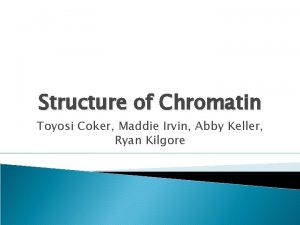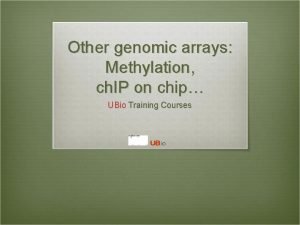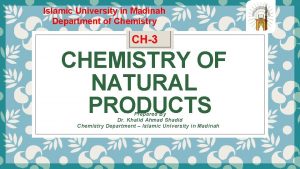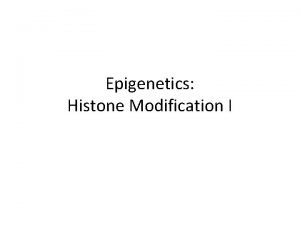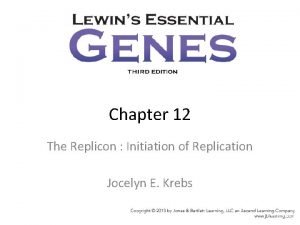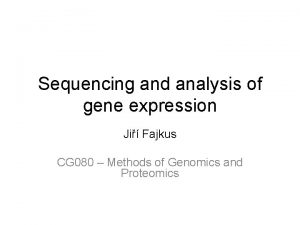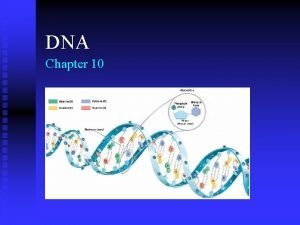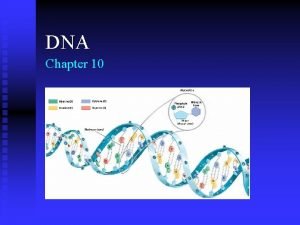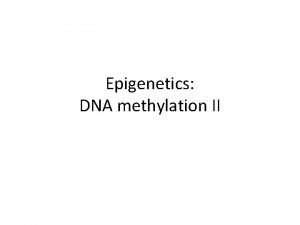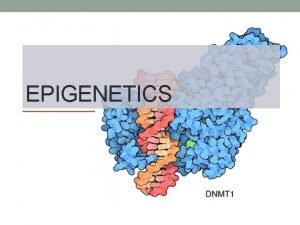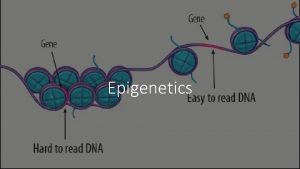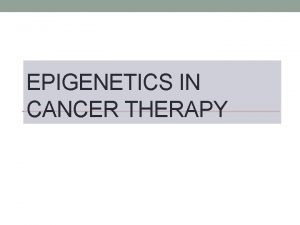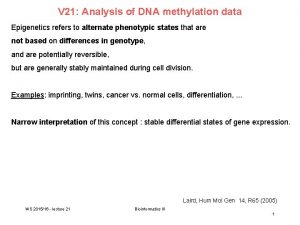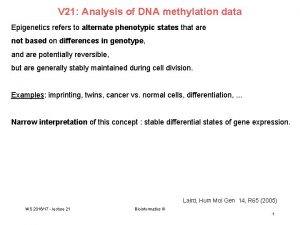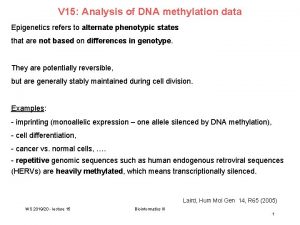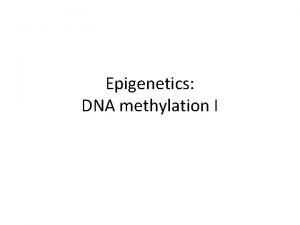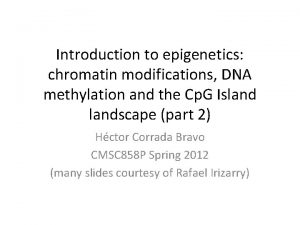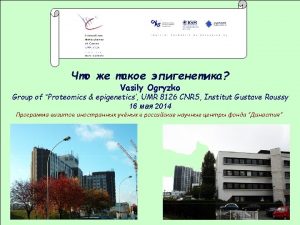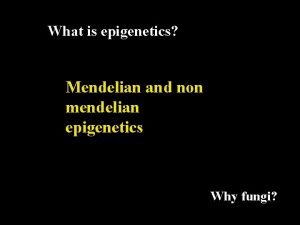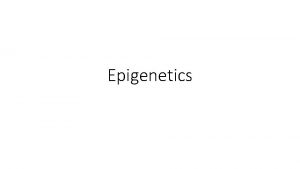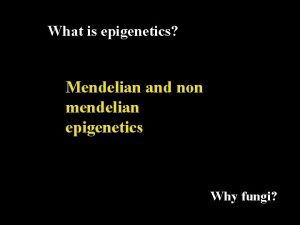Methods of DNA Methylation Analysis CNRU Review Epigenetics

















- Slides: 17

Methods of DNA Methylation Analysis CNRU

Review: Epigenetics • Study of mitotically heritable alterations in gene expression potential that are not mediated by changes in DNA sequence • Epigenetic regulation is critical for mammalian development and cellular differentiation • Epigenetic dysregulation causes human developmental diseases and cancer

Transcriptional competence is tied to regional chromatin structure • Chromatin structure depends in large part on: – Histone modifications – DNA binding proteins – Methylation of cytosines within Cp. G dinucleotides* • Modification is very stable (but is reversible) • Correlated with locus specific transcriptional status • From a clinical nutrition point of view, DNA methylation requires dietderived methyl donors and cofactors; nutrition can affect this modification • Goal: overview of methods to analyze DNA methylation

Major Advance: Conversion of unmethylated cystosines to uracil using sodium bisulfite Sequencing: unemethylated cytosines read as thymidine in sense strand; adenine in the anti-sense strand. Other technologies evolved from here.

Decision Tree: Appropriate approach depends on the goal(s) of the study For review see Shen & Waterland Curr Opin Clin Nutr Metab Care 2007 Global or locus-specific? Global Gene specific 1. Cytostine extension Genome-wide or candidate gene? 2. Bisulfite sequencing of repetitive elements 3. HPLC Genome-wide Array-based or not? Array based 1. Antibody of 5 m. C 2. binding 2. 3. Methylation-sensitive 3. Restriction enzyme 4. 3. Bisulfite modification 4. Candidate gene Quantitative or sensitive? Not Quantitative 1. RGLS 2. Digital Karyotyping 3. Library & Sequencing MSP, methyl sensitive PCR Allele specific or not? Allele specific 1. 2. Bisulfite cloning & Sequencing Sensitive Methyl light MSP Not Direct bisulfite Sequencing: • Pyrosequencing • Manual sequencing • Mass array

Global DNA Methylation Analysis: Global or locus-specific? Global 1. Cytostine extension 2. Bisulfite sequencing of repetitive elements 3. HPLC Mammals, 70 -80% of all Cp. G dinucleotides are methylated. -most of this occurs in repetitive elements or regions of low Cp. G density Cp. G rich regions (Cp. G Islands): -often found in gene promoters - ‘generally’ unmethylated HPLC: -classic method to quantify DNA methylation -highly quantitative and reproducible -requires large amounts of DNA -not suitable for high throughput analyses PCR methods: -developed to circumvent HPLC problems -approximate global DNA methylation levels by assessing repetitive elements (Alu and LINE) -require little DNA; applied to parrafin embedded tissues Disadvantage: no locus-specific information.

Global or locus-specific? Gene specific Genome-wide or candidate gene? Gene-Specific Methylation Analysis: -Can be characterized as 1. ‘candidate gene’ or 2. ‘genome wide’ approaches

Genome-wide or candidate gene? Candidate gene Quantitative or sensitive? Quantitative Allele specific or not? Allele specific 1. 2. Bisulfite cloning & Sequencing Sensitive Methyl light MSP Not Direct bisulfite Sequencing: • Pyrosequencing • Manual sequencing • Mass array Candidate gene approach: Can be divided into 1. Sensitive—methylated and unmethylated alleles are detected by designing primers overlapping Cp. G dinucleotides. 2. Quantitative—primers are designed to amplify both methylated and unmethylated alleles with equal efficiency, and methylation level is analyzed using a variety of approaches

Sensitive Methods After bisulfite modification, PCR is performed using two sets of primers designed to amplify either methylated or unmethylated alleles. • Often referred to as MSP, or methylation sensitive PCR • Highly sensitive: can detect one methylated allele in a population of > 1000 unmethylated alleles. • Samples can be of limited quantity and quality. • MSP is not quantitative. • Variations of MSP: • Methyl light & quantitative analysis of methylated alleles • Use real time PCR for methylation detection • Designed to detect fully methylated or fully unmethylated alleles • Ignores the reality of partially methylated alleles • Primer design is essential

Quantitative Methods Except for one (Southern-based) method, all depend bisulfite conversion. 1. Allele-specific bisulfite sequencing -bisulfite modification of DNA; PCR amplification of region; ligated into cloning vector; transfected into competent cells; antibiotic colonies grown, picked, & expanded; plasmid DNA isolated and sequenced. -each clone represents a single allele (yielding allele specific information) -if enough clones are picked, it can be quantitative. -technique is labor intensive and costly (Nu. Potential does this routinely). 2. Quantitative but not allele-specific -2 a. employs direct radioactive sequencing of postbisulfite PCR products and quantification using a phosphoimager. -don’t sample a subset of alleles, rather averages across alleles produced by PCR 2 b. Bisulfite PCR followed by restriction analysis (COBRA) -bisulfite modification; PCR amplification followed by digestions with a Restriction enzyme whose recognition sequence is affected by the bisulfite modification. ; quantitated using gel electrophoresis/densitometry

Quantitative Methods (cont’) 3. Bisulfite pyrosequencing -relies on bisulfite conversion and PCR amplifcation and conversion of PCR product to single stranded DNA; pyroseuencing is essentially a primer extenstion method to analyze short- to medium- length DNA sequences. -drawback: only 25 -30 bases can be sequenced in a reaction 4. Bisulfite PCR followed by MALDI-TOF MS -DNA treated with bisulfite; regions of interest are PCR amplified; product converted to single stranded DNA (T 7 polymerase) then cleaved with endonuclease; -different cleavage patterns for the methylated and unmethylated Cp. G positions are quantitated by mass spec. KEY to quantitative methods: primer design and testing for PCR bias (methylated and unmethylated DNA can be differentially amplified).

Genome-wide or candidate gene? Genome-wide Array-based or not? Array based 1. Antibody of 5 m. C 2. binding 2. 3. Methylation-sensitive 3. Restriction enzyme 4. 3. Bisulfite modification 4. Not 1. RGLS 2. Digital Karyotyping 3. Library & Sequencing Technologies are improving to increasingly enable assessment of locus-specific DNA methylation on genome wide scale.

Nonmicroarray-based genome-wide analysis 1. Restriction Landmark Genome Scanning (RLGS) -a 2 D gel technique in combination with methylationrestriction enzymes (Not. I and Asc. I) -yields methylation profiles of thousands of loci at once -Drawbacks: limited genome coverage (up to 10% of Cp. G islands) and sensitivity (requires 30% methylation to be detectable). 2. Methylation specific karyotyping (MSDK) -fairly recently developed -conceptually similar to SAGE (serial analysis of gene expression) -relies on cleavage of genomic DNA w/methylation sensitive enzyme (Asc. I) -Short sequence tags are sequenced and mapped 3. Limited digestion with Mcr. BC* -construct methylated and unmethylated domains using limiting restriction digestion with Mcr. BC; fragments transfected into E. coli and plasmid DNA sequenced -Consensus is growing that these types of approaches (which depend on massive parallel sequencing techniques) will surpass array-based approaches.

Microarray-based genome-wide analysis: 4 classes have been developed to map 5 m. C patterns 1. Methylated DNA immunoprecipitation (Me. DIP) -requires immunoprecipitation of DNA using antimethylcytosine antibody followed by hybridization to DNA microarrays. -requires large amounts of genomic DNA and antibody -two modifications to improve sensitivity: a. Ligation-mediated PCR (LM-PCR)-requires blunt end ligation (poor efficiency) and appears to bias towards GCpoor regions* b. methylated Cp. G island recovery assay (MIRA)* -applied to genome-wide methylation analysis in cancers -requires a column purifications step; columns not commercially available. *a & b lack sensitivity

Microarray-based genome-wide analysis (cont. ) 2. Oligo arrays -incorporates bisulfite PCR and specially designed oligo arrays; quantifies bisulfite induced C to T change at defined genomic positions; -requires gene specific PCR, but method can interrogate multiple Cp. G sites within hundreds of genes at once; -approach does no represent the entire genome; primer design can be challenging. 4. Differential hybridization -genomic DNA digested with Mse. I (methylation independent), ligated with linkers, then digested with Bst. UI or Hpa. II (methylation sensitive) to remove unmethylated fragments); digested DNA is amplified, products labeled and hybridized to array.

Microarray-based genome-wide analysis (cont. ) 4. Methylated Cp. G island amplification combined with microarray (MCA) -uses methylation sensitive and insensitive isoschizomers -DNA incubated w/ methylation sensitive restrcition enzyme (Sma. I) that digests unmethylated DNA, leaving methylated DNA in tact; -the same DNA is then digested with a methylation insensitive Sma. I isoschizomer (Xma. I). Sma. I leaves blunt ends Xma leaves sticky ends; Xma adapters allow adapter specific PCR; product labeled and hybridized to array. -OK for cancer; we had no luck with diets, etc.

Conclusion • High throughput methods for genome-wide methylation analysis are being developed • Should become commercially available in the next few years • But, methylation changes detected by the developing methods will still need to be validated using locus specific methods • Nutrition offers a key challenge: induces subtle changes in DNA methylation (unlike cancer model)
 Methylation vs acetylation
Methylation vs acetylation Methylation & chip-on-chip microarray platform
Methylation & chip-on-chip microarray platform Herzig meyer method
Herzig meyer method Histone modification epigenetics
Histone modification epigenetics What is epigenetics
What is epigenetics Adenine methylation
Adenine methylation Replication
Replication Bioflix activity dna replication lagging strand synthesis
Bioflix activity dna replication lagging strand synthesis Coding dna and non coding dna
Coding dna and non coding dna What are the enzymes involved in dna replication
What are the enzymes involved in dna replication Dna and genes chapter 11
Dna and genes chapter 11 Dna sequencing methods
Dna sequencing methods A-wax pattern recognition
A-wax pattern recognition Section 10-1 review discovery of dna
Section 10-1 review discovery of dna 3 types of rna
3 types of rna Dna review packet
Dna review packet Chapter review motion part a vocabulary review answer key
Chapter review motion part a vocabulary review answer key Ap gov review final exam review
Ap gov review final exam review
